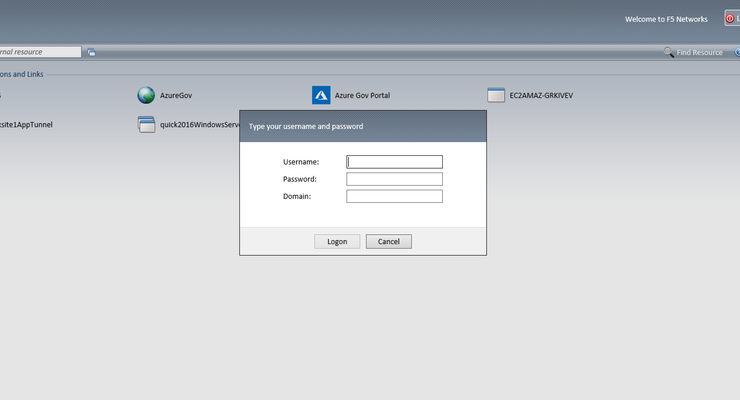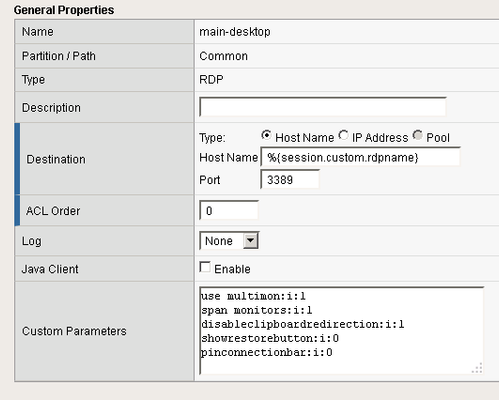remote desktop
12 TopicsChange Webtop Remote Desktop Icon
I have an access policy for VMware VDI and I can't seem to change the icons for my webtop/remote desktop links. The default icon is "terminal_service.png" located in /var/sam/www/webtop/public/images/full_wt I have changed this to an icon with the same dimensions (32px) in Access Policy>Customization>Basic>Remote Desktop and General>Branding>Remote Desktops but still the old icon is dispayed. Any ideas?865Views0likes7CommentsCan't maximize RDP sessions with internet explorer - APM
I see a few similar posts on here about this but no definitive answer. I have Microsoft Remote Desktop shortcuts on my APM and they connect fine and maximize, but if you exit full screen, then it locks the screen to a small size. You can't resize or even maximize again and the maximize button becomes greyed out. Pretty unusable after that point. I thought this might be a bug when I was running 11.4 but I have upgraded to 11.6 and have the same issue. Anybody had the same issues and know how to fix this? Thanks781Views0likes11CommentsAPM "Remote Desktop Web Access" Kerberos SSO option
Currently working with a customer who is very interested in APM's Remote Desktop Web Access feature. MFA is strictly enforced in this environment so username and passwords are a no go, so NTLM is out. But within the Remote Desktop Web Access object definition, there is a "Kerberos SSO Configuration" option where you can select a predefined Kerberos SSO profile. Through contextual clues, I assumed that this would be to setup a Kerberos Constrained Delegation scenario. Mostly geared towards environments where passwords are not an option. In setting this up.. I have confirmed that the Windows server hosting the RemoteApp Web portal has been setup to accept Windows Integrated authentication along with assigning the appropriate SPNs to the Computer Object in AD. I have validated that kerberos authentication works going directly to the RemoteApp web portal (bypassed forms page, saw the security event of the kerberos logon within windows security events, etc etc). I have setup the delegation account in AD for the kerberos SSO profile and have verified that it has the appropriate permissions and delegated spns. After all of this I still receive the logon box from Webtop requiring a username, password and domain. I haven't found any documentation on this particular option in APM, "Remote Desktop Web Access". So my question is, Can a KCD setup be done with this APM feature and is this particular Kerberos SSO drop down used in this setup? If it can not be done, what does this Kerberos SSO drop down menu do? Thanks any and all who can share their wisdom!757Views0likes0CommentsAPM Remote Desktop auto-logon without password fails
Hi all, I am trying to configure auto logon for remote desktop for one of my clients with blank/empty password. Quite a strange requirement but... So, I am struggling trying to get it to work. I am using custom session variables to pass domain and username information but having trouble passing an empty password. I have tried to set pw variable string to and leaving it empty but that just results in failed login or refusal to attempt to logon. Leaving Password source blank neither works. Does anyone have an idea how to do this the right way if possible at all? Thanks in advance. Alex600Views0likes5CommentsAPM :: Remote Desktop List :: Remote Sound Not Working
Has anybody ran into where the remote audio is not being played locally? I have the local sound box checked, and I even tried the audiomode:i:0 custom parameter (even though it's defaulted to zero), and neither seem to be working. I know it's nothing wrong with the workstation (or so it seems) because the other VPN solution that I'm trying to migrate off of works perfectly fine. General Properties: Local Resources: I haven't been able to get monitor spanning to work either (no matter what combination of anything I use)... but that's a whole other issue. Thanks-479Views0likes2CommentsWhy use F5 for MS RDS if I still need connection brokers?
I've read the 2 main guides written for iApps : http://www.f5.com/pdf/deployment-guides/microsoft-rds-session-host-dg.pdf written for manual creation : https://www.f5.com/pdf/deployment-guides/f5-microsoft-remote-desktop-services-dg.pdf But I'm relatively new to configuring our F5 so I don't quite understand a few things. Our plan is to deploy 5ish session host servers, 3ish web access servers, and 1 license server We do not currently have plans for RD Gateway (for external access) Everything I read about the Connection Brokers however basically says that if you have multiple connection brokers and you set up DNS roundrobin they will load balance between all your session host servers and all is well. Then when I read the F5 guides they say that if I want to still be able to direct users to an existing session host where they already have a disconnected session I still need connection brokers. So my question is, if I still need connection brokers anyway, why even do anything with the F5? Why not just use DNS roundrobin, send users directly to the connection broker farm, which then directs them to the appropriate session host. What advantages do I gain by using the F5? (other than health monitoring)461Views0likes1CommentAPM :: Remote Desktop List :: Monitor Span/Multimon
Has anybody been able to get monitor spanning to work with an RDP access resource? Neither of these parameters appear to work: I opened a support case with F5 - but the engineer was not entirely helpful. When asking about Java RDP spanning: The short answer is no, Span support isn't available for the Java RDP client. It is possible to configure the MSTSC.exe client to support span however if you absolutely need it. This has been brought up as an RFE on multiple occasions and is a limitation of the underlying Java RDP implementation that PD has said they won't change. When asking about RDP spanning with the native (Windows) client: I am certain I have seen the mstsc monitor span successful with the *span monitors:i:1*. I don't recall off hand if it was using an access portal or the client itself. When pressing about the response: I only saw it work in a lab environment when I was testing against a previous bug with the active x control RDP module. I hadn't configured it, one of my colleagues did and I may have been mistaking what I saw (he may have been connecting directly to a windows box, not through the F5). Does he just not feel like helping people today? If that was my answer to one of my customers I'd be getting some heat from my boss. Our SE says that Mac will have an official RDP launch client (non-Java) and the mstsc launcher has some updates in version 13 that's coming out soon. Not sure if that's the root of my problems or not - and I'm not really interested in upgrading to .0 code right now... so I'd really like to get this to work at least on Windows... Mac is what it is at the moment unless I buy the HOB client (which I likely won't get approval for from management - not to mention it will look really bad when I ask for more money to do something we already have working in the environment with the solution we're replacing ). Thanks-442Views0likes1CommentLoad balancing Remote Desktop 2012R2 with F5 instead of Connection Broker.
Microsoft Issues: We have a Remote Desktop deployment of around 60 Session hosts, 2 HA connection brokers, 3 gateways, and 3 web access servers. We have had trouble with Microsoft's load balancing and session directory services provided by the connection broker. specifically, there are circumstances when are specific session host may become unresponsive, some users on it are working, but new users can't connect. the host can't be removed from the collection as it is not responding to WMI request. the only option we have is to hard reboot it and kick everyone off it. since the host has a low number of users it also becomes a magnet for new connections and effectively takes down the entire cluster as far as new connections are concerned. another scenario is we lose a session host without it being able to power down gracefully (hardware failure) the session directory seems to keep record of all the users on that host and attempts to reconnect them to it even though it is dead and gone. those users can not longer connect. the only way to resolve is restarting the connection broker and causing a cluster wide outage. Potential for F5 magic: Our desire here is to replace the load balancing responsibility with the F5, which we have better health checking capabilities, better load balancing decision making, and better central control over which nodes are active in a pool. We would like to be able to disable a problematic node with the F5 and have new connections directed to other session hosts while existing users on that host are allowed to continue until attrition allows us to restart it. We'd like to incorporate better health monitoring to identify problematic hosts prior to receiving calls from our clients. Trouble with interaction between F5 and RDP deployments After setting up the latest version of the RDP Session host IApp and doing some testing we are finding some issues with the F5 performing load balancing. We have the Session hosts set to use Token redirection in order to get the F5 to forward users to appropriate session hosts where existing sessions are located (session directory), if it is left in IP redirect mode then these redirects cause the RDP client to attempt to bypass the F5 virtual server and access another host directly. The problem we are running into is that no matter what node the F5 decides to balance the user to, that session host will perform a load balancing election with the connection broker and issue a redirect token to a different node. So the F5 cannot perform any load balancing. Furthermore, if we have a problematic host and we disable it in the F5 the F5 will continue to accept the redirect tokens for the disable hosts. Even if we set it to force offline the F5 will still attempt to connect to the offline host specified in the redirect and a connection failure will be returned to the RDP client. So the F5's ability to manage which hosts receive connections is rendered completely moot. We attempted to find and disable the "Connection broker load balancing" option in the registry which was used in previous versions of RDP, but this does not seem to stop the redirection tokens from being issued by the session host, in fact it seems to break session directory so that once a user is assigned a host it will never realize they disconnected, and permanently hold that user to that host regardless of session status. Problem There seems to be no means to have F5 perform any authoritative load balancing or connection management among Remote Desktop 2012R2 session collections. What then is the point of putting all this behind an F5 virtual server... Request Anyone out there with experience running MS Remote Desktop 2012R2 session hosts via the F5 LTM virtual server that is able to perform load balancing/connection management, any tips or reference configurations?403Views0likes1CommentRdp that ask the user for ip or host name as resource
Hi everyone! I have an apm policy that publish rdp based on AD Group Resource Assign. i need to add an option ,on the same virtual server and access policy ,to let the user that successfully logged on, to write an hostname or ip address of a remote computer and then open rdp to that object. How do i add this option parallely? Thanks,375Views0likes4Comments




